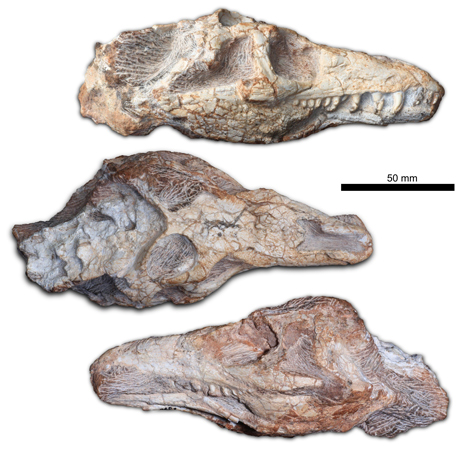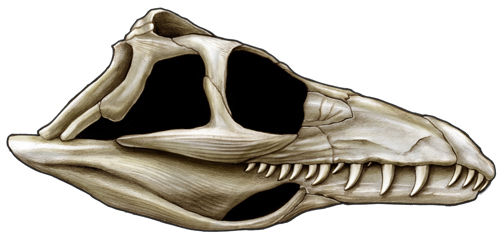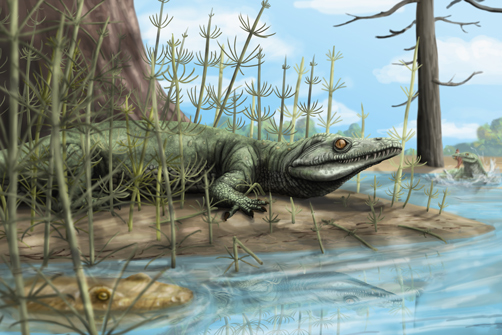New Reptile Species “Just before the Dinosaurs”
The academic journal “Scientific Reports” published today contains a paper detailing the discovery of a remarkably well preserved fossil reptile, one that existed not long after the End Permian mass extinction event. The fossil, an amazing and nearly complete skull described by the scientists as “extraordinary” plus some cervical vertebrae (neck bones) provides an important link between primitive reptiles and the Archosauriforms that gave rise to modern crocodiles, the Pterosauria, Aves and of course the dinosaurs.
Fossil Reptile Discovery
The 1.5-metre-long reptile, probably filled an ecological niche similar to today’s smaller crocodile species. Ambushing smaller vertebrates as they came down to the water’s edge to drink. It may also have hunted amphibians and fish in the shallows. Named Teyujagua paradoxa the fossil material comes from the Sanga do Cabral Formation located in the Brazilian State of Rio Grande do Sul in the far south of the country.
The Skull of Teyujagua paradoxa
Picture credit: Scientific Reports
The picture above shows three views of the “extraordinary” skull right lateral view (top), dorsal view (middle) and left lateral view (bottom). Scale bar equals five centimetres.
“Fierce Lizard”
The fossil material was discovered early last year by a field team from the Paleobiology Laboratory of the Universidade Federal do Pampa (Brazil), the genus name means “fierce lizard” in the local dialect of the Guarani, a name inspired by a mythological and magical beast called Teyú Yaguá. The species name “paradoxa”, from the Greek for paradox or unexpected, denotes the fact that the fossils show an unusual combination of primitive and more advanced, derived characteristics.
An Illustration of Skull of “Fierce Lizard” Teyujagua paradoxa
Picture credit: Scientific Reports
The teeth particularly those of the maxilla are large, serrated and curved, the teeth of a carnivore. The large orbit (eye socket) and the position of the nostrils suggest that this animal could lie in wait for prey under water with only its nostrils above the surface of the water, a typical predatory strategy adopted by many crocodiles today.
Living After the Permian-Triassic Extinction Event
The authors of the report state that this fossil find is significant as Teyujagua lived just after the Permian-Triassic extinction event, a mass extinction event that wiped out 90% of all terrestrial vertebrates. Teyujagua provides new insights into how ecosystems on land recovered and developed following this extinction. After the extinction, terrestrial ecosystems were sparsely populated, providing opportunities for some groups of survivors to expand in number and diversity. Archosauriforms and their close kin like Teyujagua became the dominant animals in terrestrial habitats, eventually giving rise to the Dinosauria.
An Artist’s Reconstruction of Teyujagua
Picture credit: Voltaire Neto
An Exciting Discovery
Dr Felipe Pinheiro, from Universidade Federal do Pampa, São Gabriel, Rio Grande do Sul and the corresponding author for the scientific paper stated:
‘The discovery of Teyujagua was really exciting. Ever since we saw that beautiful skull for the first time in the field, still mostly covered by rock, we knew we had something extraordinary in our hands. Back in the lab, after slowly exposing the bones, the fossil exceeded our expectations. It had a combination of features never seen before, indicating the unique position of Teyujagua in the evolutionary tree of an important group of vertebrates.’
Although, it is difficult to precisely date the Sanga do Cabral Formation, the fossils have been dated based on faunal comparisons with the Karoo Basin deposits of South Africa. The scientists infer that Teyujagua dates from the Induan to the early Olenekian faunal stage of the Early Triassic (around 251-249 million years ago).
More Tetrapod Fossils Found
Along with the skull and cervical vertebrae of T. paradoxa, the field team excavated fossil material associated with the parareptile Procolophon trigoniceps along with temnospondyl amphibians and a number of as yet unidentified tetrapod bones.
Dr Richard Butler, from the University of Birmingham’s School of Geography, Earth and Environmental Sciences, who also co-authored the scientific paper commented:
‘Teyujagua is a really important discovery because it helps us understand the origins of a group of vertebrates called archosauriforms. Archosauriforms are spectacularly diverse and include everything from hummingbirds and crocodiles to giant dinosaurs like Tyrannosaurus rex and Brachiosaurus. Teyujagua fills an evolutionary gap between archosauriforms and more primitive reptiles and helps us understand how the archosauriform skull first evolved.”
The Teyujagua quarry is still being excavated and the researchers are confident that they will find more Teyujagua fossil material along with some more, and perhaps equally “extraordinary” tetrapods.









Leave A Comment